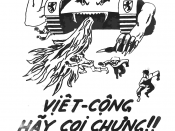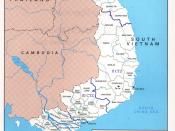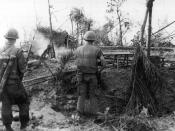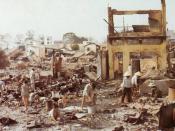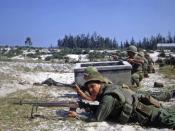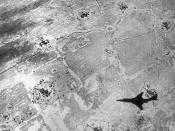George Santayana has argued that "those who cannot remember the past are condemned to repeat it". Of course, remembering the past does not guarantee success in the present. It does, however, reduce the likelihood of repeating past errors by providing a frame of reference for making decisions. This essay argues that, on the whole, American policymakers failed to heed the lessons of the past during the Vietnamese war. More specifically, the United States (U.S.) government and its military and political collective leadership failed to consider the historical context of the Vietnam War; did not appreciate the nature of previous conflicts in Vietnam; underestimated the strength of will, the resolve and the sheer commitment of the enemy that had been exhibited in previous wars; and did not understand the actual nature of the war that it was fighting. These grievous errors greatly reduced the chances of U.S. victory. The essay does not content that this failure to understand the pass was the only reason for the U.S.
defeat. Some commentators hold that the U.S. actually won the war on the tactical level but lost on the only level that matters - the strategic, political level . Others criticise the military leadership for employing an inadequate military strategy to defeat a communist insurgent movement, for misleading the civilian leadership and the American people by providing overly optimistic assessments that the war was being won, and for being more concerned about their careers than winning the war. Similarly, it has been argued that the civilian leadership placed so many political constraints upon the military leaders responsible for conducting the war that they made it impossible to win. Whatever the merits of these various contributions, this essay argues that an understanding of the past in Vietnam may have lessened the extent of the defeat and its impact on the American psyche . This impact has been summarised by Henry Kissinger: "Vietnam is still with us. It has created doubts about American judgement, about American credibility, about American power - not only at home but U.S. involvement throughout the world. So we paid an exorbitant price for the decision that we made in good faith. "An appreciation of the basics of Vietnamese history would have been a good starting point for U.S. policymakers. Over the centuries, the Chinese, the Japanese, and the French have attempted to exert control over Indochina. Vietnam's history is a litany of resistance to such attempted foreign domination. For example, in both the 13th and the 15th centuries, Vietnam initially fell to Chinese invaders but subsequently successfully rebelled against the invading power. Western invasions commenced in 1858 with a series of French military thrusts. By 1883, the whole of Vietnam was under French control and administered as part of French Indochina. French colonial rule continued until May 7, 1954, when the French were defeated by the Vietnamese at Dien Bein Phu. Shortly afterwards, in a land with a long history of repelling foreign invaders, the United States entered the conflict. It did not take the time to examine the lessons learned from the French involvement in Indochina.
Throughout these centuries, and out of the experiences of these long wars and resistance to invaders, the Vietnamese people have forged a strong collective identity. Though subdued militarily at various times, this identity has always re-asserted itself, leading to renewed political expression. This political expression has been greatly aided by a single, common language, a shared tradition, and a united territory with a history of heroic resistance to foreign rule. Leaders who fulfilled this image could attract intense loyalty and enormous sacrifice from the population. But those leaders who succumbed to foreign pressure, or accommodated foreigners for personal gain could not count on public support, except from a small percentage of the population - that portion that had benefited from foreign exploitation. Arguably, few U.S. policy makers understood the nature and the influence of these past conflicts. Rather they regarded the war as a re-run of the Korean War - a war to stop the spread of Communism - and did not understand that the Vietnamese viewed the conflict with the U.S. as just a continuation of 2000 years of foreign oppression. And, based on its history, this was an invasion that could be repelled.
Crucially, the U.S. did not remotely understand the political and military will and determination of the Vietnamese, based on their past and on their culture, and in particular did not appreciate that the North Vietnamese were prepared to accept limitless casualties in its conflict with the United States. The North Vietnamese political leader, Ho Chi Minh brutally set out his parameters for victory: "You can kill ten of my men for everyone I kill of yours. But even at those odds, you will lose and I will win." Ho Chi Minh and his allies were prepared to do whatever was necessary to resist this latest foreign occupation. They were prepared to accept limitless casualties to attain their objective. General Vo Nguyen Gap, the Communist commander, discounted the life of thousands of human beings. He spoke of fighting ten, fifteen, twenty, fifty years, regardless of cost, until "final victory." Even if the battle was to be that of a "microbe against a leviathan" , the essential reality of the struggle was that the North Vietnamese were imbued with an almost fanatical sense of dedication to a reunified Vietnam.
The enemy's perseverance was confirmed by American civilians and soldiers who served in Vietnam. Patrick J. McGreevy, a CIA analyst, noted in 1969 that no price was too high for Gap as long as he could deplete American forces, since he measured the situation not by his casualties, but by "the traffic in homebound American coffins." Konrad Kellen, a RAND Corporation expert, noted that "short of being physically destroyed, collapse, surrender, or disintegration was - to put it bizarrely - simply not within their capabilities". The ability to accept the casualties which the U.S. war of attrition imposed was central to the success of North Vietnamese strategy. Their attacks were designed to have maximum psychological effect. They were able to choose the time and place of most of their attacks that were most advantageous to them. Therefore, with the exception of the TET offensive, they were able to control their casualties by avoiding contact with opposing forces when desired. In effect this attrition strategy was a test of wills which the United States could not endure.
This essential fact largely escaped American strategists who based their analysis on their own values rather than those of the Vietnamese. U.S. General Westmoreland believed that by "bleeding" them, he would awaken their leaders to the realization that they were draining their population to the point of national disaster for generations, and then compel them to sue for peace. After the war, Westmoreland noted that "an American commander who took the same losses as General Gap would have been sacked overnight".
Neither could intensive bombing of the North Vietnamese break their resolve. The United States Air Force dropped 7.8 million tons of bombs during this war, an amount greater than the total dropped by all aircraft in all of World War II. Since the North Vietnamese, unlike Germany in World War II, did not possess munitions plants or industries vital to its war effort, infrastructure such as roads, bridges, and transportation complexes were targeted. Such targets, however, could be quickly repaired, moved, or circumvented and therefore had to be bombed again and again. Nor could intensive bombing curtail the flow of men and supplies over the Ho Chi Minh trail. Evidence suggests that the heavy bombing only increased the resolve of the North Vietnamese resistance. Strategic targets in major population centres could not be bombed due to political considerations. General Curtis Lemay, U.S. Air Force, advised "bombing them into the stone age." Yet, in 1972 after the most intensive bombing of the North had destroyed virtually all industrial, transportation, and communications facilities built since1954, flattened three major cities and twenty-nine province capitals, the North's party leaders replied that they had defeated the U.S. "air war of destruction." Short of nuclear destruction (or an all out invasion of North Vietnam, as some advocates suggested) the air war alone could not force the North Vietnamese to succumb to pressures that the British and Germans had survived during World War II. Only much later did American officials begin to perceive the determination of the North Vietnamese. Dean Rusk, secretary of state under Presidents Kennedy and Johnson, finally admitted in 1971 that he had personally underestimated the ability of the North Vietnamese to resist. General Maxwell Taylor, who had contributed to Kennedy's decisions on Vietnam and served as Johnson's ambassador in Saigon, neatly summarised the lack of preparedness and knowledge of the U.S.: "First, we didn't know ourselves. We thought we were going into another Korean war, but this was a different country. Secondly, we didn't know our South Vietnamese allies. We never understood them, and that was another surprise. And we knew even less about North Vietnam. Who was Ho Chi Minh? Nobody really knew. So, until we know the enemy and know our allies and know ourselves, we'd better keep out of this dirty kind of business." Kissinger, like his predecessors, never found the breaking point of the North Vietnamese. He had concluded that they would compromise only if menaced with total annihilation. The North Vietnamese agreed to a cease fire in October 1972 only after he had handed them major concessions that were to jeopardize the future of the South Vietnamese government.
In formulating a strategy to defeat the North Vietnamese, the U.S. military leaders arguably did not understand the nature of the war. Were they fighting a counter-insurgency war, for example, or a full conventional war against North Vietnam? Summers, in his book On Strategy, strongly argued the failure of the U.S. military leadership to perceive the true nature of the Vietnam War. He offers the view that the North Vietnamese insurgency was a tactical screen masking their real objective, the conquest of South Vietnam through conventional means. Summers argues that the failure to invoke the national will was one of the major strategic failures of the Vietnam War. It produced a strategic vulnerability that the United States enemy was able to exploit. If the Constitutional requirement for a congressional declaration of war had been accomplished, it would, he argues, have ensured public support and, through the legal sanctions against dealing with the enemy, impeded public dissent. Regardless of the validity of this analysis, a key point that emerges is the impact of the act of committing American forces in a remote part of the world without a formal declaration of war. North Vietnam posed no direct threat to the U.S. Why, then, were nearly 1 million U.S. troops fighting in Vietnam? The reason for U.S. involvement in Vietnam was to contain communist expansion. However, even this policy of containment was not intended to be applied on the Asian continent. Based on the history of the American people and their relationship with its army, a prolonged war will not be supported unless U.S. interests are directly threatened. In this context, Donaldson argues the need to define the nature of war: U.S. leaders "must also carefully consider, define, and communicate to the American people what are U.S. vital interests and which interests that they are willing to die for."In conclusion, it is clear that the U.S. policymakers did not understand the historical context of the Vietnamese war nor of previous conflicts in Vietnam; neither did they appreciate the sheer will of the enemy nor the nature of the war. In short, they failed to heed the "lessons" of the past. It is not possible to conclude that that such failure led to the defeat of the U.S. forces in the Vietnamese war. What is clear, however, is that, ultimately, through ignoring these lessons, the possibility of victory was greatly reduced.
BIBLIOGRAPHYAllison, Fred H. "Remembering the Vietnam War: Changing Perspectives over Time", The Oral History Review, Vol. 31, No. 2, 2004, pp. 69-83.
Baritz, Loren. Backfire: A History of How American Culture Led Us into Vietnam and Made Us Fight the Way We Did. New York: Morrow, 1985.
Bergerud, Eric M. Red Thunder, Tropic Lightning: The World of a Combat Division in Vietnam. Boulder: Westview, 1993.
Cooper, Chester L. The Lost Crusade: America in Vietnam. New York: Dodd, Mead & Co., 1999.
Davidson, Phillip B. Secrets of the Vietnam War. Novato, CA: Presidio, 1990.
Donaldson, Gary A. America at War since 1945: Politics and Diplomacy in Korea, Vietnam, and the Gulf War. Westport, CT: Greenwood, 1996.
Elliott, David. The Vietnamese War: Revolution and Retribution, 1930-1975. Armonk, NY: M.E. Sharpe, 2003.
Goodman, Sue A. Rolling Thunder: Air Strategy, Selected References. Maxwell AFB, AL: Air University Library, 1993.
Hess, Gary R. Vietnam and the United States: Origins and Legacy of War. Boston: Twayne, 1990.
Jamieson Neil L .Understanding Vietnam. Berkeley: University of California Press, 1993.
Kinard, Douglas. War Managers. New Hampshire: University Press, 1977.
Michael, S. "Vietnam War and the US: Haunting Legacy", Economic and Political Weekly, Vol. 36, No. 21, 2001, pp. 1793-1795.
Santayana, George. The Life of Reason, Volume 1. Amherst, N.Y: Prometheus Books, 1905.
Shivkumar, M. S. "Reconstructing Vietnam War History", Political Investigation, Vol. 31, No. 1, 1996, pp. 21-22.
Summers, Harry. On Strategy. California: Presidio Press, 1982.
Turley, William. The Second Indochina War. New York: Westview Press, 1986.
Zinoman, Peter. The Colonial Bastille: A History of Imprisonment in Vietnam, 1862-1940. Berkeley: University of California Press, 2001.
